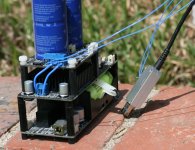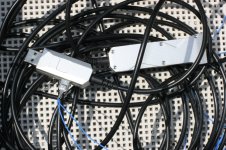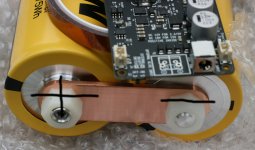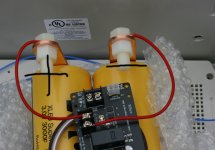Hi Ian !
I am a bit confused when reading about UcPure mklll. I have ordered a 9vac trafo for use it with UcPure mklll ( ac mode)
But when reading the manual, it seems that 12v trafo is correct.
3.3vdc is what I need ( FifiPi clean side) and maybe 9v ac is enough ?
Edit; when reading about UcPure mklll on the france web store audiophonics, it seems that 9v ac is ok. Or…..?
I am a bit confused when reading about UcPure mklll. I have ordered a 9vac trafo for use it with UcPure mklll ( ac mode)
But when reading the manual, it seems that 12v trafo is correct.
3.3vdc is what I need ( FifiPi clean side) and maybe 9v ac is enough ?
Edit; when reading about UcPure mklll on the france web store audiophonics, it seems that 9v ac is ok. Or…..?
Last edited:
@Drive Shaft
I posted a detailed Video on how to assemble the UCPure with Eaton's Ultra Capacitors use it as a rough guide but still do your own research and observe all safety parameters and build at your own Risk. I suggest you cover the Eaton's screws or shrink wrap the entire Caps and use the Fused switched output when feeding your project. Finish building your project on a steady plank tie the Caps down to the plank to avoid things moving then Charge last. Be safe and Enjoy the music.
I posted a detailed Video on how to assemble the UCPure with Eaton's Ultra Capacitors use it as a rough guide but still do your own research and observe all safety parameters and build at your own Risk. I suggest you cover the Eaton's screws or shrink wrap the entire Caps and use the Fused switched output when feeding your project. Finish building your project on a steady plank tie the Caps down to the plank to avoid things moving then Charge last. Be safe and Enjoy the music.
@Gabster 2000 ,
Thanks for the info.
All my zip ties, shrink wrap is boxed up for now but I think I have some electrical tape lying around. I haven't thought about taping up the ends.
This is just testing for now and not going to be ready for production yet so I just have the UcPure on top on kapton tape roll inside a industrial strength container.
Thanks for the info.
All my zip ties, shrink wrap is boxed up for now but I think I have some electrical tape lying around. I haven't thought about taping up the ends.
This is just testing for now and not going to be ready for production yet so I just have the UcPure on top on kapton tape roll inside a industrial strength container.
- Attach bussbar on -+ to Series Eaton 3000F.
- + - needed on other side, so they each have their individual bussbar.
- Attach - bussbar to - J7 with 18G Solid Core Cooper.
- Attach + bussbar to + J7 with 18G Solid Core Cooper.
- Confirm with community it's good to go.
- Plug in with Medical Grade Mean Well 19V SMPS.
For those whom went through the UcPure experience, when you have time to go through Steps 1-6 please let me know if that looks fine.
This is purely for 3.3V so no balancer board at this time.
I'll plug into the wall outlet to pre-charge once I have enough confidence sample sizes. Cheers.
Last edited:
I'm not happy with all current balancer board solutions. So I'm trying to make a better one which is new the UcBalancer.

UcBalancer0 by Ian, on Flickr

UcBalancer0 by Ian, on Flickr
The UcBalancer is beautiful. Dream come true.
The only alternative brand name balancer boards have rivets and I don't want to deal with rivets.
So this Summer is going to be fun. UcBalancer plus millions of RPi's going to flood the market.
I was hoping for a TuringPi2 build with GPIO but too much latency for Audio Applications.
The only alternative brand name balancer boards have rivets and I don't want to deal with rivets.
So this Summer is going to be fun. UcBalancer plus millions of RPi's going to flood the market.
I was hoping for a TuringPi2 build with GPIO but too much latency for Audio Applications.
Ian, I try again.
Is 9v trafo ok for 3.3v on UcPure mklll ? Normally is this no problem as 9v ac is 12.6v dc after the rectifiers, and 9.3v dc should be enough for good regulation, or am i missing something ?
Is 9v trafo ok for 3.3v on UcPure mklll ? Normally is this no problem as 9v ac is 12.6v dc after the rectifiers, and 9.3v dc should be enough for good regulation, or am i missing something ?
@smooth dancerIan, I try again.
Is 9v trafo ok for 3.3v on UcPure mklll ? Normally is this no problem as 9v ac is 12.6v dc after the rectifiers, and 9.3v dc should be enough for good regulation, or am i missing something ?
UcPure was designed for a wide input voltage range. 9V AC has no problem work for 3.3V configuration. Please go ahead.
My suggests for power supply solutions:
3. For top project: LinearPi 5V with UcConditioner 5V for Rpi, UcPure 3000F 3.3V for FifoPi clean side and the rest.
I think this will be my Summer Project.
Right now I'm using the LiFePO4 6.6V -> LinearPi 5V -> UcConditioner 5V for my Monoprice USB Optical Cable. For the Solid Core wiring, I went too thin and hoping to go 20G-24G soon. This is for Gaming, not Music. I game on a low latency realtime kernel OS but for Music I prefer pure 16-bit Redbook that only Ian's gear + RPi GPIO can provide most optimally. I would hate if that 32-bit USB conversion would have to ever take place on the Music side. I also run low latency realtime on the Raspberry Pi so optimal on both RPi and PC. Both also load the OS entirely in RAM, so if I launch a game it's completely loading and running in RAM.
Custom kernel linux-raspberry4-rt 6.1.15 LTO is pretty awesome with Ian's gear.
Since there has been talk of "Sharing", I'm going to try to share powering the RPi and Monoprice USB Optical Cable at the same time with LiFePO4 6.6V -> LinearPi 5V -> UcConditioner 5V. I hope no major road bumps with UcPure 3.3V.
I believe I use a Medical Grade 12V Mean Well to power this chain. Everything else I use Medical Grade 19V Mean Well.


Last edited:
Hi @iancanada / others,
I'm not sure if this is the right sub forum. I don't have any soldering or previous DIY experience, but I really want to build the flagship Streamer in this doc (https://github.com/iancanada/DocumentDownload/blob/master/FifoPi/FifoPiQ7/FifoPiQ7Manual.pdf). I think I understand all the other components except the power supply. The main goal and motivation i have to build the streamer is to experiment with clocks and other power supplies (including other transformers). I have few questions
1. I'm not really sure how to hook up the transformer. According to the pdf it is Hammond 1182N6 transformer. In the image, I see 4 output wires going to the LinearPi Dual. But so far I have not been able to figure out what happens to the input cables of the transformer. How do I connect them to the AC? According to the transformer data sheet (https://www.mouser.com/datasheet/2/177/1182-736858.pdf), the transformer has 4 input cables. How do they plug into the AC main? Are there connectors that I can use to connect them to AC mains?
1.1. Are there any utility cases where installing the transformer is easy (making mistakes for newbie is minimal)
1.2 How do I test the power supply and transformer before hooking them up that I have done the right thing and destroy anything downstream?
2. What are the best clocks that can play DSD1024 (i will be using HQPlayer NAA, and HQPlayer to upsample to DSD1024).
Thanks is advance for the help.

I'm not sure if this is the right sub forum. I don't have any soldering or previous DIY experience, but I really want to build the flagship Streamer in this doc (https://github.com/iancanada/DocumentDownload/blob/master/FifoPi/FifoPiQ7/FifoPiQ7Manual.pdf). I think I understand all the other components except the power supply. The main goal and motivation i have to build the streamer is to experiment with clocks and other power supplies (including other transformers). I have few questions
1. I'm not really sure how to hook up the transformer. According to the pdf it is Hammond 1182N6 transformer. In the image, I see 4 output wires going to the LinearPi Dual. But so far I have not been able to figure out what happens to the input cables of the transformer. How do I connect them to the AC? According to the transformer data sheet (https://www.mouser.com/datasheet/2/177/1182-736858.pdf), the transformer has 4 input cables. How do they plug into the AC main? Are there connectors that I can use to connect them to AC mains?
1.1. Are there any utility cases where installing the transformer is easy (making mistakes for newbie is minimal)
1.2 How do I test the power supply and transformer before hooking them up that I have done the right thing and destroy anything downstream?
2. What are the best clocks that can play DSD1024 (i will be using HQPlayer NAA, and HQPlayer to upsample to DSD1024).
Thanks is advance for the help.
@NeoTheOne
If you don't have soldering and other DIYT experience, I would suggest you step by step. Start from building a transport streamer to feel the clocks and power supplies.
https://www.diyaudio.com/community/...fight-the-jitter.192465/page-414#post-7263122
Solution one is a good start point for you.
Later on, you can upgrade it to higher levels and have fun meanwhile.
Regards,
Ian
If you don't have soldering and other DIYT experience, I would suggest you step by step. Start from building a transport streamer to feel the clocks and power supplies.
https://www.diyaudio.com/community/...fight-the-jitter.192465/page-414#post-7263122
Solution one is a good start point for you.
Later on, you can upgrade it to higher levels and have fun meanwhile.
Regards,
Ian
UcBalancer is a special designed protection board to integrate ultracapacitors better with UcPure or other power supply.
With a full set of UcBalancer KIT, it makes things much easier to build top level power supplies for clocks, streamers or DACs.

UcBalancer1 by Ian, on Flickr

UcBalancer0 by Ian, on Flickr

UcBalancer2 by Ian, on Flickr
With a full set of UcBalancer KIT, it makes things much easier to build top level power supplies for clocks, streamers or DACs.
- All connectors are fully assembled so there is no need for any soldering jobs.
- 1A high dumpling current with PTC fuses for a double protection
- With two ultracapacitor direct continuous outputs to get a best possible performance
- Comes with all accessories for a clean and easy installation

UcBalancer1 by Ian, on Flickr

UcBalancer0 by Ian, on Flickr

UcBalancer2 by Ian, on Flickr
@iancanada thanks for the suggestion. I can start from something more simple. But for my knowledge, what is the right way to hook the transformer up in the above build?
I have 3 of these now and a superb upgrade from MKII.UcPureMkIII New features
#41C github.com/iancanada/DocumentDownload
• Add a powerful SYNC UC charging function. Can re charge the UCs during music stops. T his
feature can avoid the output voltage drop or trigger the protection mode even if you listen to music
for a very long time. SYNC control signal can be connected to the MUTE signal of a FifoPiQ7. M ore
UcPure MKIII can work together with this signal as a control chain This signal is isolated from
UcPure MkIII so it doesn’t affect the power supply performance at all.
• Upgrade to higher capacitance, higher voltage and ultra low ESR smoothing capacitors. Make the
UcPure MKIII works better for both AC and DC input and tolerance more to different input power
supplies.
• Upgrade to heavy duty high performance 10A fast acting standard 5*20 mm glass fuse
• Optimized for both DC and AC inputs
• Bigger and stronger ON/OFF switch on top side of the PCB
• More than one UC group s can be in parallel to improve performance more
UcPureMkIII by Ian, on Flickr
I use 9v on my @smooth dancer and working perfect@smooth dancer
UcPure was designed for a wide input voltage range. 9V AC has no problem work for 3.3V configuration. Please go ahead.
EXCELLENT!!!! Thanks Ian and I will be purchasing these once available. Much cleaner solutionUcBalancer is a special designed protection board to integrate ultracapacitors better with UcPure or other power supply.
With a full set of UcBalancer KIT, it makes things much easier to build top level power supplies for clocks, streamers or DACs.
- All connectors are fully assembled so there is no need for any soldering jobs.
- 1A high dumpling current with PTC fuses for a double protection
- With two ultracapacitor direct continuous outputs to get a best possible performance
- Comes with all accessories for a clean and easy installation
UcBalancer1 by Ian, on Flickr
UcBalancer0 by Ian, on Flickr
UcBalancer2 by Ian, on Flickr
When you receive the transformer there is a label explaining what each colour wire is for. The 4 wires will be, 2 wires for 115v AC and another 2 wires for 115v AC. Here in the uk I would join these in series to give me 2 wires to connect to the live and neutral of the 230v AC mains. I do not recommend you play with mains electricity unless you know what you are doing as it can kill you. just sharing info as you we asking@iancanada thanks for the suggestion. I can start from something more simple. But for my knowledge, what is the right way to hook the transformer up in the above build?
When you receive the transformer there is a label explaining what each colour wire is for. The 4 wires will be, 2 wires for 115v AC and another 2 wires for 115v AC. Here in the uk I would join these in series to give me 2 wires to connect to the live and neutral of the 230v AC mains. I do not recommend you play with mains electricity unless you know what you are doing as it can kill you. just sharing info as you we asking
So, Ideally for my case where I do not have prior experience with transformers, I should try to get prebuilt LPSUs?
Are there cases, safe tests that can make using transformers safer, more specifically if we talk about Hammond 1182N6 transformer which has two 6V output?
Is there a way to learn how to build power supplies from somewhere? All I see are electrical engineering degrees. I would just love to learn practical applications for now.
Last edited:
Hello!
Sorry for this way,to get in contact with you,ian canada...! I tried to ask you a question over iancanada.mail@gmail.com,but didn't receive an answer till now.was it the right way,or do you have another place to do this?
Greetz from germany
Andreas kuhn
Sorry for this way,to get in contact with you,ian canada...! I tried to ask you a question over iancanada.mail@gmail.com,but didn't receive an answer till now.was it the right way,or do you have another place to do this?
Greetz from germany
Andreas kuhn
- Home
- Source & Line
- Digital Line Level
- Asynchronous I2S FIFO project, an ultimate weapon to fight the jitter




